Reflections on Springboard’s intensive trainings
For over a decade, Springboard for the Arts has been offering business skills workshops to artists to help them build a living and a life. Since 2017, we have offered an annual series of intensive trainings building on the professional development and entrepreneurship workshops we have developed, and on our artist-led community development practice. Here, we check in with a number of past participants in these trainings to learn more about what they were able to take away from these trainings and how they have implemented what they learned in their own organizations or artistic practices.
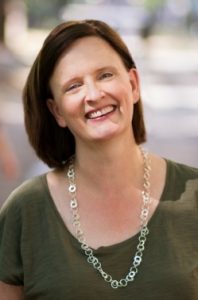
Luann Jennings is the project manager for artist professional development and networking at Creative Waco. She participated in the Work of Art: Business Skills for Artists Intensive Training in 2018.
I have a background in the arts business: I started in theatre companies and by running an arts ministry in a church. I had people coming to me discouraged that their careers weren’t going well and I realized a lot of it was because they weren’t treating their arts practice as a business. I got interested in arts entrepreneurship and business development then.
Three years ago I moved to Waco, Texas for this position with Creative Waco. I was interested in creating artist development programs for them. In my research I found Work of Art and I wanted to learn more than what was in the workbook. There were a few things I didn’t understand because I’m a theater artist, not a visual artist, and I also felt like the workbook was addressing more experienced artists, too. I went to the training and it was great.
Waco is a much smaller community than the Twin Cities. When I came back from the training the first course I put together was working off of Work of Art, specifically the workbook.
I knew artists here needed more work on the front end, the kind of mindset stuff—planning, strategy—so I ended up using Work of Art as a jumping off point and inspiration. It was something in the background while I developed things that seemed more on the level of the artists coming in here.
I call our curriculum “The Work of Artists” so it still has the connection to the original Work of Art and shows that it was inspired by Work of Art. There are still a couple of pages in the workbook I copied and use as they are.
I use the business plan essentials unit from the workbook a lot. So many of my folks come in saying, “I just want to make money on this.” And I say, “Okay, back up, before someone gives you money they have to believe that what you’re doing is of value to them.” So we go back and do all that value proposition work—who is it buying, how do you find them, how do you communicate to them. I’m hoping to get to the point that I have enough people who have gone through intro level that I can add an intermediate level as they’re a little further along.
I go back through the workbook regularly because I so very much trust the process that went into the development of that workbook and that curriculum. At this point, it is an inspiration and maybe a building block, even though I went in another direction.
I just got a $50,000 grant from the Tremaine Foundation to build out more of what I’m doing and also create a business incubator. I felt I needed a little more leverage to get artists here. We have a great university with great programs turning out really skilled kids, but then they all graduate and leave the area. Part of what we’re trying to do is keep them here and give them something here that they could get in a bigger city, along with cheaper rent and a better quality of life.
After the training, I stayed in touch with some of the folks from Springboard. I just think everything they do is great. What Springboard is doing is what so many communities need.
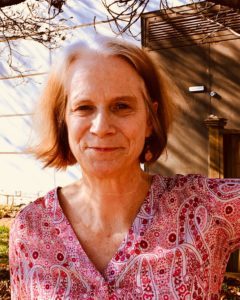
Joan Lynch is the director of arts enterprise in the Arlington Cultural Affairs | Arlington Arts office of the Arlington County government in Virginia. She participated in the Intensive Training in 2017, which included both Work of Art and artist-led community development work.
I was amazingly impressed by the entire training program. I was not familiar with Springboard prior to going to this training, but about a month beforehand my supervisor said I should go, so I went to the first “Train-the-Trainer” session.
We had already started a training program at that time but it really hadn’t got off the ground yet because I was waiting for two offices to be built into a training center, and that took a year and a half. Now we have a physical space that is a training center specifically for artists by artists, and I got that idea from Springboard. We didn’t start the program because of the training I attended, but we enhanced the program greatly.
You realize how much money is in the area you live in when you go to trainings in an area like Minneapolis. They don’t have the type of funding in the Twin Cities that we have just through our tax base alone in the Washington D.C. area. There is so much disposable money here for people to go out and do whatever they want. It really hit me that I didn’t really feel a lot of people are appreciative of how much funding they actually get.
The training center, called the Arts Enterprise Institute, stemmed out of a grant program we have here in Arlington. I had been a grant officer for nine years prior to this position. The Institute was supposed to be an incubator program with the hopes of organizations getting seed money to then go out and apply for their own grants.
What we ended up learning was that a lot of organizations came to expect the assistance from us, but they were staying stagnant. They mentioned they didn’t get any training for fundraising and sponsorships, so we held a capacity building workshop for these organizations, and only four showed up. We had proven the training was not the issue; the issue was that these were small groups without the time to attend the workshops or focus on capacity building, or they didn’t want to grow because they were happy where they were.
That completely changed the whole mission behind the Institute, and it became about artists and not arts organizations. We did not want to exclude them but we also understood that there are artists in arts organizations and we wanted them to be able to come to us in any capacity they wanted.
There is a huge difference between training for organizations and training for artists. When I got back from the Springboard training I did a 360 and said, “It’s all about artists now.” I felt that was a much more progressive way of looking at it.
After I got back from the training, I also decided we will do our training as a fee recovery program. I figured if I can get 50 percent or more recovery of the fees I give to instructors, then I think things are going well. Then I would hope to present that to the board and get more money annually.
I’d really like to get the trainings on a more permanent schedule. We really blasted them out before the space was available and used another space in the building for our workshops. We started them in the summer but that was not a good time; this area is much more based on the scholastic year and fiscal year. The biggest thing I’m having trouble with now is marketing and having staff to market these trainings, and not just through Facebook or Twitter. We need to market this as a program, not as specific workshops. I’m going to start building a marketing plan to see if we can get a consistent marketing sense with this program so people will be aware of it and become repeat customers.
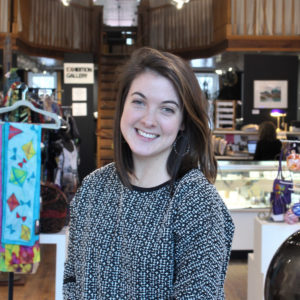
Kara Maloney is the advancement director of Lanesboro Arts in Lanesboro, Minnesota. She participated in the Intensive Training in 2017, which included both Work of Art and artist-led community development work.
I completed the Springboard for the Arts training in 2017 and since then have spoken a few times at local colleges about artists working in communities, and business skills for arts students.
When I was in college, from 2012 to 2016, I interned at Springboard for the Arts and ended up doing my senior project on creating a program integrating Springboard’s business skills classes for art students to take during their time at college. This program did get implemented as a one-month course.
This past year it has been a goal of mine to start classes in our region. I have talked to local artists about that possibility. I recently got on our regional arts council board, which I’m hoping to help implement the courses through but have not made any moves yet. We also applied for a grant through RETHOS, which would use some of the community development skills, and we could use strategies through Springboard if we receive the grant. I also received a small grant to activate a local empty lot in town and hope to engage artists in that space as well, but will wait until spring 2020.
I am really excited for the potential to use the skills I learned at some point, but my capacity is limited right now, especially with starting new programs. I truly appreciated the program in its accessibility with scholarships to bring people from rural Minnesota to get these trainings. I also appreciated the fact that Springboard brought a “Train-the-Trainer” group to Lanesboro to use our community as a case study.
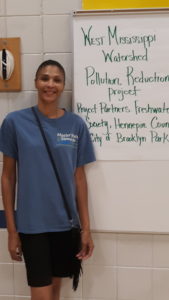
Kimberly Carpenter is an artist living and working in Brooklyn Park, Minnesota. She participated in the Artists Working in Community training in 2018.
I was drawn to the program because it sounded similar to a program I went through with Intermedia Arts and I wanted to reconnect with artists, art, and art making. It just sounded like it would be a really wonderful opportunity to re-engage with the arts community.
I was still actively working as an artist, but I really struggled to call myself an “artist.” I still struggle with that, but the program really helped me to learn how to be more skillful in working in the community as an artist and with other artists.
I like to do community health art projects. I like to infuse and use art to improve community health and health outcomes. I just completed a drain mural project in River Park.
The biggest takeaway for me was how to honor artists—their expertise, their craft, their vision, their ideas, their voices—in the whole process of designing vibrant and healthy communities. We got some tools that I used in my capstone project: I had to do a call for artists and I had to build a team of artists. There were drafts in the workbooks that we got, including templates for how to create an RFA or RFQ, so I used those. I reached out to Sam Buffington (community organizer with Springboard) with my RFA and he helped me get it distributed to artists in the community. I just felt more equipped and empowered to reach out to other organizations in search of additional artists. It was really helpful to have that training that made me feel so much more confident.
Being at the training and just being around other artists is really key for people like me who struggle to put themselves out there artistically. Just having an opportunity to be able to share in that space really helped. It helps you get more courageous in sharing your work.
Also, I got a scholarship to be able to attend the training. I want to impress that I wouldn’t have been able to go to the program without that scholarship, so I’m really grateful that Springboard is able to give that out.
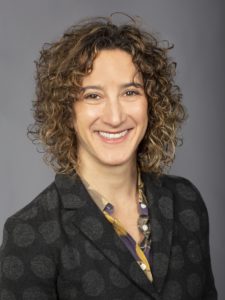
Shoshana Zeldner is the program manager for the School of the Arts at University of Nevada, Reno. She attended the Artists Working in Community training in 2018.
I heard about “Artists Working in Community” from the Nevada Arts Council, where I was the community arts development director, before I got this job. Jun-Li Wang, community development program director for Springboard, came out to lead a session at our conference the first year I was there. She’s been a great support for a lot of projects I’ve worked on.
In my role with the Nevada Arts Council, I worked with organizations all over the state of Nevada to improve the work they’re doing, but also to run strategic planning, community planning, and visioning planning statewide. Nevada is a small state in terms of population. I really connected with Springboard’s approach to gathering community input and buy-in in those community planning meetings I was involved with, and I started really thinking about who was in the room and who was not.
While doing that work I was also working with the city of Sparks, Nevada, and helped them write an Our Town grant last year, which they won. I worked with Springboard a bit on that and they hired Springboard to do some work for them. The way I envisioned that project was totally informed by my past work, and also by Springboard’s approach to working with community through Ready Go. The best thing about the Ready Go resource is that Springboard just wants to work with artists and get artists doing stuff. In the public sphere, there’s way more hesitancy to just hand over money. The ability to experiment is lessened; things move slower.
We don’t have a lot of artists here in Northern Nevada working in the community at all. When we had been talking with Jun-Li on writing that grant, part of it was about collecting public input on future public art to be installed in downtown Sparks. I thought it would be cool to commission local artists to develop mobile arts tools to gather that public input, and to do that modeled after Ready Go. Jun-Li and Peter Haakon Thompson (community development coordinator with Springboard) both came out and did workshops with the artists who expressed interest, and gave them some tools to use to do this work. All summer long they were using those mobile concepts to gather public input.
Before coming to Nevada I was at the Crocker Art Museum in Sacramento. We gave three different grants to artists in Sacramento for community arts projects, but we had no support or infrastructure for the artists. We were a museum doing something that a museum typically doesn’t do, and I really saw how you need to make sure artists are prepared along the way to do this kind of work—just having a few workshops isn’t enough. There was a lot of learning in the failure and frustrations from that. From the tools I got from Springboard I could see it in a different way, and had a better sense of how to better support the artists through the process of community engagement.
At the University of Nevada, Reno, I am supported to do work with artists in the community, but I have a lot to do; my job is really big. I am certain that I will get there, and I know that I will even if it’s solely on a personal level.
When I did this training with Springboard I was still at the Nevada Arts Council; I didn’t even know about this job at UNR. I was hired for it because of my experience with community engagement and working in the community. My involvement with Springboard and that training helped me get to where I am in this position, which I just started this past February. I work in the School of Arts and our dean is really passionate about community engagement and having an impact beyond the university. I think that’s why I was hired.
Right now I’m in the middle of planning the next season of our performing arts series. We bring in artists from all over country and world to perform here, and I get to create opportunities for them to perform for new audiences or people who might not otherwise come to our shows. The things I’ve learned from Springboard have helped me in working with the artists here, but also in working with out-of-area artists on how they engage with this audience and the people here.
I’ll be doing some gathering of public input on our campus at some point. I was thinking of having one of the artists from Sparks bring his mobile project to campus. I’ll be thinking of new ways to gather public input from what I learned from Springboard.
Springboard has instilled in me the idea to not to forget about your local artists. Because I’m bringing in artists who are working or touring at a certain level, there is an expectation to put an artist of a certain caliber on the stage. Another thing I’ve struggled with is finding the balance of me bringing these artists in, but also making space for similar artists doing great work in the same genre locally, and what kind of opportunities there are for collaboration and partnership there. Now I’m trying to find ways to connect with local artists and help grow local capacity with local artists.
Lead image: Kimberly Carpenter’s drain mural project (courtesy of the artist).
